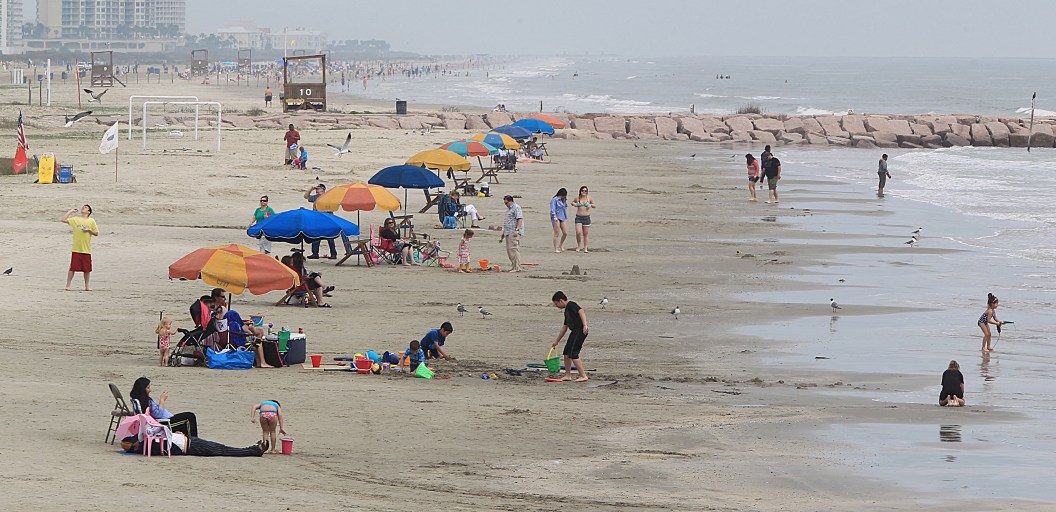Summer means beach vacations—but before you dive head-first into that pristine blue water, you should probably hear some new scientific findings that came out this week. More than half of America's beaches are contaminated with the unthinkable: poop.
Of the 3,200 beaches tested for Environment America's 2022 report, 55% of them had at least one day when fecal contamination reached potentially unsafe levels. While one day of contamination may not sound that bad—what are the chances it's your day, after all?—it's hard to believe poop on the beach is an isolated occurrence. In fact, these unsafe levels surpassed the Environmental Protection Agency's (EPA) most protective "Beach Action Value," a precautionary, conservative tool that states use to know when to set beach advisories or close the beach because of health risks.
No one wants to swim in poopy water, and not just because it's disgusting. It comes with a wide range of health issues, including respiratory and gastrointestinal diseases, ear and eye infections, and skin rashes. Environment America notes that there are 57 million reported cases of water-borne illnesses in the U.S. every year.
Which Beaches Have the Highest Levels of Feces?
The Gulf Coast as a region tested the worst, with 84% of the coastline failing to meet the EPA standards. Texas was the most soiled state in the area, with 90% of its 60 tested beaches deemed unsanitary.
Louisiana and Pennsylvania scored top marks for overall grossness, with 100% of their beaches failing the safety standards. On the other hand, Alaska and Hawaii were the cleanest by far; just 24% of their beaches being deemed unsafe for at least one day in 2022.
One could argue, though, that 1 in 4 beaches being contaminated by poop is still one beach too many.
Seeping Sewage
All this poop has to come from somewhere, and the report identified sewers, private septic tanks, and animal waste from industrial farms as the main offenders. Environment America believes that inadequate or poorly maintained sewage infrastructure around the United States is allowing raw sewage to seep into the country's waterways.
Urbanization isn't helping either, as the increase in impervious surfaces such as parking lots also increases the flow of polluted stormwater into rivers, bays, and coastal waters. And, as more wetlands and forests are lost to pavement, there is less available land to absorb rainwater and filter pollution, further worsening the runoff problem.
Lastly, livestock are to blame, as livestock production inherently causes fecal pollution. Factory farming in particular is an issue, simply because of the sheer volume of poop it produces. These mega-farms often create more manure than surrounding areas can absorb, unlike smaller, traditional farms. The excess manure is generally carried off by rainwater into nearby creeks and rivers, and then is washed down to lakes and coastal waters—and onto beaches.
Cleaning Up the Crap
Thankfully, Congress passed the Infrastructure Investment and Jobs Act in 2021, which directly provides $11.7 billion for sewage and stormwater projects, and authorizes an additional $14.65 billion for that purpose. The EPA estimates that the actual need is closer to $271 billion, but the act is a start.
Public investment in natural and green infrastructure also needs to increase, as steps such as permeable pavement, urban green spaces, and rain barrels help prevent stormwater pollution. Protecting wetlands will help with the absorption of floodwaters and the filtering of pollutants. Environment America also recommends moratoriums on new or expanded industrial-scale livestock operations, including banning waste lagoons in flood-prone areas.
And, perhaps, the easiest way to keep beachgoers safe: expanded beach testing to identify where pollution has reached harmful levels.
Despite Environment America reporting that 55% of America's beaches were contaminated to unsafe levels, only 29% of beaches in the EPA's reporting program had one or more advisory or closing in 2022. Without expanded testing, many beaches that should have been closed for unsafe contamination may not have been.
READ MORE: Dirty Jobs: Hunters Field Dress a Gut-Shot Deer




